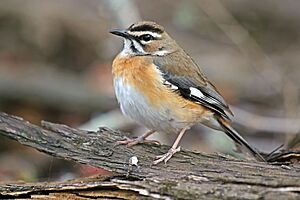Bearded scrub robin facts for kids
Quick facts for kids Bearded scrub robin |
|
|---|---|
 |
|
| At Phinda Private Game Reserve, KwaZulu Natal, South Africa. | |
| Conservation status | |
| Scientific classification | |
| Genus: |
Cercotrichas
|
| Species: |
quadrivirgata
|
| Synonyms | |
|
Tychaedon quadrivirgata |
|
The bearded scrub robin (Cercotrichas quadrivirgata) is a small, active bird. It lives in parts of eastern and southern Africa. This bird is also known as the eastern bearded scrub robin. It is famous for its beautiful song and the unique "stripes" on its face. It belongs to the Muscicapidae family, which includes many types of flycatchers and chats.
Contents
About This Bird
What's in a Name?
Scientists gave this bird its name, Thamnobia quadrivirgata, in 1879. It was later moved to the Erythropygia group. Now, it's usually placed in the Cercotrichas group. The word quadrivirgata comes from Latin. It means "four-striped." This name fits the bird perfectly because it has four clear stripes on its face.
This robin is part of a group of birds called a superspecies. This means it's very closely related to the forest scrub robin, miombo scrub robin, and brown scrub robin. Sometimes, these four birds are put into a different group called Tychaedon.
There are two main types, or subspecies, of the bearded scrub robin:
- C. q. greenwayi: This type lives on the Zanzibar and Mafia Islands.
- C. q. quadrivirgata: This type lives in most other areas.
Where It Lives
The bearded scrub robin is found in many countries in eastern and southern Africa. These include Botswana, Eswatini, Kenya, Malawi, Mozambique, Namibia, Somalia, South Africa, Tanzania, Zambia, and Zimbabwe. Its total living area is very large, covering about 5.39 million square kilometers.
This bird usually lives in areas below 1,000 meters (about 3,300 feet) in height. You can find it in sandy forests, woodlands near rivers, and evergreen forests. Sometimes, it even visits gardens and areas with reeds. It usually avoids very wet places.
In the 1950s, some of its homes were lost due to trees being cut down. However, in other places, the bird's range has actually grown. For example, in the 1940s, a spray was used to control tsetse flies in the Hluhluwe-Umfolozi Game Reserve. The robins disappeared for a while but came back by 1975. They have also started living in new areas like Matobo National Park and Richards Bay.
What It Looks Like
The bearded scrub robin is about 15 to 17 centimeters (6 to 6.7 inches) long. It weighs around 20 to 31 grams (0.7 to 1.1 ounces). Males and females look very similar, but the female is usually a little smaller.
Its head and upper body are mostly a dark olive-brown color. Its tail is dark brown, with white tips on the outer feathers. The feathers covering its wings are grey-brown with olive-brown edges. The main flight feathers are dark brown and have a white patch.
On its face, it has several clear markings:
- A white stripe above its eye (called a supercilium).
- A white crescent shape just below its eye.
- A white line on its "mustache" area.
- A black stripe below its eye (called a malar stripe).
- There are also black lines above its white supercilia.
Its eyes are dark brown, and the area between its eyes and beak (lores) is black. Its throat and upper chest are white. The rest of its chest and the sides of its neck are a reddish-brown color. Its belly and the feathers under its tail are white. The beak is black, and its legs are pinkish-brown.
Young bearded scrub robins look a bit different. They are paler brown with black patterns on their head and back. Their underparts are a light yellowish-brown with dark patterns. The C. q. greenwayi type has greyer upper parts, a duller rump, and a paler chest.
How It Behaves
The bearded scrub robin is usually seen in pairs or small groups. It makes different sounds, like chuck, chrrrt, chek-chek-kwezzzzzzz, and seeeep. Its song is a series of beautiful whistles. It can even copy the songs of other birds!
This bird finds its food on the ground. It mainly eats insects like ants, termites, and beetles. It also enjoys taking "sand baths" to clean itself.
Bearded scrub robins are monogamous, meaning a male and female stay together for breeding. They are also very territorial. They will defend their home area, which can be as large as 1 hectare (about 2.5 acres).
The breeding season changes depending on where they live:
- Eastern Africa: December to February
- Malawi, Zambia, and Zimbabwe: September to January
- South Africa: September to December
Their nest is built from plants, lichen, and animal hair. A female usually lays two to three eggs. The eggs can be white, pale green, or bluish, and they often have many spots. The female bird sits on the eggs to keep them warm until they hatch.
Its Status in the Wild
We don't know the exact number of bearded scrub robins in the world. However, this species lives in a very large area. Its population seems to be stable, meaning it's not decreasing quickly. Also, there are no major threats to this bird right now. Because of these reasons, the IUCN Red List has listed the bearded scrub robin as a species of least concern. This means it is not considered endangered or at high risk of disappearing.


